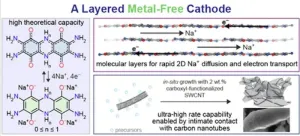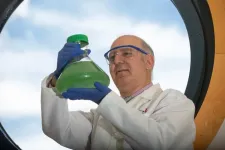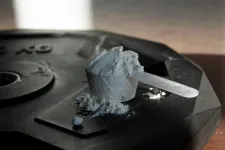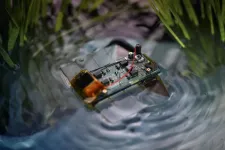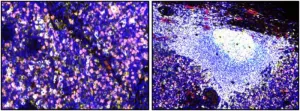(Press-News.org) For decades, scientists have sought ways to counter our dependence on lithium-ion batteries. These traditional, rechargeable batteries energize today’s most ubiquitous consumer electronics – from laptops to cell phones to electric cars. But raw lithium is expensive and is often sourced through fragile geopolitical networks.
This month, Princeton University’s Dincă Group announces an exciting alternative that relies on an organic, high-energy cathode material to make sodium-ion batteries, advancing the likelihood that this technology will find commercialization with safe, cheaper, more sustainable components.
While scientists have made some progress with sodium-ion batteries, hurdles arise largely because of their low energy density: they have shorter battery-run times relative to their size. High power density, which relates to output, also factors into their performance. Achieving high energy density and high power density simultaneously has been an ongoing challenge for alternative batteries.
But the cathode material put forward by the Dincă Group, a layered organic solid called bis-tetraaminobenzoquinone (TAQ), outperforms traditional lithium-ion cathodes in both energy and power densities in a technology that is truly scalable.
Their research has potential for large-scale energy storage applications like data centers, power grids, and commercial-scale renewable energy systems, in addition to electric vehicles.
“Everyone understands the challenges that come with having limited resources for something as important as batteries, and lithium certainly qualifies as ‘limited’ in a number of ways,” said Mircea Dincă, the Alexander Stewart 1886 Professor of Chemistry. “It’s always better to have a diversified portfolio for these materials. Sodium is literally everywhere. For us, going after batteries that are made with really abundant resources like the organic matter and seawater is among our greatest research dreams.
“Energy density is something on a lot of people’s minds because you can equate it with how much juice you get in a battery. The more energy density you have, the farther your car goes before you have to recharge it. We’ve answered quite emphatically that the new material we developed has the largest energy density, certainly on a per kilogram basis, and competes with the best materials out there even on a volumetric basis.
“Being on the front lines of developing a truly sustainable and cost-effective sodium ion cathode or battery is truly exciting.”
With funding from Automobili Lamborghini S.p.A., the lab’s research, High-Energy, High-Power Sodium-Ion Batteries from a Layered Organic Cathode, appears this month in the Journal of the American Chemical Society (JACS).
Approaching theoretical maximum capacity
The lab underscored the advantages of TAQ a year ago when they first reported on its utility for making lithium-ion batteries in ACS Central Science. Researchers simply continued investigating its potential, particularly when they found TAQ to be completely insoluble and highly conductive, two key technical advantages for an organic cathode material. A cathode is an essential component of all polarized devices.
So they endeavored to construct an organic, sodium-ion battery using the same material, TAQ. The process took about a year, as researchers had to adapt several design principles that could not be ported over from lithium-ion technology.
In the end, the results exceeded their expectations. Their cathode’s performance nearly is close to a benchmark known as the theoretical maximum capacity.
“The binder we chose, carbon nanotubes, facilitates the mixing of TAQ crystallites and carbon black particles, leading to a homogeneous electrode,” said Dincă Group Ph.D. and first author on the paper, Tianyang Chen. “The carbon nanotubes closely wrap around TAQ crystallites and interconnect them. Both of these factors promote electron transport within the electrode bulk, enabling an almost 100% active material utilization, which leads to almost theoretical maximum capacity.
“The use of carbon nanotubes considerably improves the rate performance of the battery, which means that the battery can store the same amount of energy within a much shorter charging time, or can store much more energy within the same charging time.”
Chen said TAQ’s benefit as a cathode material also include its stability against air and moisture, long lifespan, ability to withstand high temperatures, and environmental sustainability.
High-Energy, High-Power Sodium-Ion Batteries from a Layered Organic Cathode was authored by Tianyang Chen, Jiande Wang, Bowen Tan, Kimberly Zhang, Harish Banda, Yugang Zhang, Dong-Ha Kim, and Mircea Dincă.
END
Princeton Chemistry demonstrates high-performance Sodium-ion cathode towards new battery technology
The Mircea Dincă Group develops a sodium-ion cathode using a layered, organic material called bis-tetraaminobenzoquinone (TAQ) that outperforms traditional lithium-ion cathodes in both energy and power densities.
2025-02-19
ELSE PRESS RELEASES FROM THIS DATE:
New study links dust storms to increased emergency department visits in the U.S. Southwest
2025-02-19
DENVER - A new research study highlights the significant health risks associated with dust storms, revealing an increase in emergency department (ED) visits for respiratory and cardiovascular conditions, as well as motor vehicle accidents, in three Southwestern U.S. states. The study, which was led at National Jewish Health was published this month in JAMA Network Open.
Researchers at National Jewish Health, Emory University and the University of Colorado analyzed over 33,500 ED visits across Arizona, California and Utah from 2005 to 2018. The findings ...
Stopping asthma in its tracks
2025-02-19
LA JOLLA, CA—Current asthma treatments don't work in all patients, and they don't provide long-term relief from potentially deadly asthma attacks.
Scientists at La Jolla Institute for Immunology (LJI) are advancing a new kind of therapy. According to a recent study published in the Journal of Allergy and Clinical Immunology, their approach holds promise for providing long-lasting relief for people with asthma—and it may be useful for dampening immune inflammation in general.
The researchers have developed two therapeutic ...
Chlorine plus UV light degrades toxins caused by harmful algae blooms
2025-02-19
Treatment plants use a combination of tools to keep toxins and contaminants out of drinking water.
Researchers with the University of Cincinnati examined two such tools in addressing a toxin produced by harmful algae blooms, which are becoming increasingly common in waters around the world.
Blue green algae can reproduce en masse in waters laden with nitrogen, phosphorus or other excess nutrients. These algae “blooms” also can form when water levels drop during droughts or when bottom sediments heavy with nutrients get churned up in a storm, said Minghao Kong, a doctoral graduate of UC’s ...
In Denmark, rural cat owners are neutering their cats and allowing them indoor access
2025-02-19
Cat owners in the Denmark countryside are increasingly managing their cats in the same way as urban cat owners, resulting in fewer unwanted kittens being born, according to a study published February 19, 2025, in the open-access journal PLOS One by Peter Sandøe from the University of Copenhagen, Denmark, and colleagues.
Populations of unowned domestic cats – whether unsocialized feral cats that have never lived with humans, or socialized cats that have strayed or been abandoned – are regarded as problematic in many countries. It is argued that they are a nuisance, that they transmit disease to humans, owned cats and ...
Young people who use multiple muscle-building supplements are more likely to report symptoms of muscle dysmorphia
2025-02-19
Young people who use multiple muscle-building supplements are more likely to report symptoms of muscle dysmorphia, per Canadian study of more than 2,500 adolescents and young adults.
####
Article URL: https://plos.io/3EyuhD6
Article Title: Muscle-building supplement use is associated with muscle dysmorphia symptomatology among Canadian adolescents and young adults
Author Countries: Canada, France, U.S.
Funding: This study was funded by the Connaught New Researcher Award (#512586; KTG) at the University of Toronto. The funders had no role in study design, ...
A miniature swimming robot inspired by marine flatworms
2025-02-19
Swimming robots play a crucial role in mapping pollution, studying aquatic ecosystems, and monitoring water quality in sensitive areas such as coral reefs or lake shores. However, many devices rely on noisy propellers, which can disturb or harm wildlife. The natural clutter in these environments – including plants, animals, and debris – also poses a challenge to robotic swimmers.
Now, researchers in the Soft Transducers Lab and the Unsteady flow diagnostics laboratory in EPFL’s School of Engineering, and at the Max Planck Institute for Intelligent Systems, have developed ...
Natural hydrogen: a sustainable energy source in mountain ranges
2025-02-19
The successful development of sustainable georesources for the energy transition is a key challenge for humankind in the 21st century. Hydrogen gas (H2) has great potential to replace current fossil fuels while simultaneously eliminating the associated emission of CO2 and other pollutants. However, a major obstacle is that H2 must be produced first. Current synthetic hydrogen production is at best based on renewable energies but it can also be polluting if fossil energy is used.
The solution may be found ...
Scientists identify a new cancer immunotherapy target: Dysfunctional B cells
2025-02-19
University of Pittsburgh School of Medicine and UPMC Hillman Cancer Center scientists have discovered a novel subset of cancer-fighting immune cells that reside outside of their normal neighborhood – known as the tertiary lymphoid structure – where they become frustratingly dysfunctional when in close contact with tumors.
Described today in the journal Science Translational Medicine, the finding gives oncologists a new target for developing immunotherapies: double negative memory B cells, so-called because they are negative for two markers found on the surface of their more common brethren. They may also be a useful diagnostic ...
New Australian dinosaurs and the oldest megaraptorid fossils in the world
2025-02-19
Groundbreaking research published today in the Journal of Vertebrate Paleontology has unveiled a landmark discovery – fossils of the world’s oldest known megaraptorid and the first evidence of carcharodontosaurs in Australia. These finds rewrite the evolutionary history of theropod dinosaurs, uncovering a predator hierarchy unique to Cretaceous Australia.
The research, led by Museums Victoria Research Institute and Monash University PhD student Jake Kotevski, describes five theropod fossils discovered along Victoria’s coastline. The fossils were unearthed in the upper Strzelecki Group (Bunurong/Boonwurrung ...
EMBARGOED: Study reveals activity of navtemadlin in glioblastoma, points to possible treatment improvements
2025-02-19
Study Title: Window of opportunity trial reveals mechanisms of response and resistance to navtemadlin in patients with recurrent glioblastoma
Publication: Science Translational Medicine
Dana-Farber Cancer Institute authors: Veronica Rendo, PhD, Eudocia Q. Lee, MD, MPH, Veronica Rendo, PhD Patrick Y. Wen, MD, Keith L. Ligon, MD, PhD, Rameen Beroukhim, MD, PhD
Summary: Clinical research by Dana-Farber scientists suggests that combining a novel agent called navtemadlin with DNA-damaging chemotherapy for the treatment of glioblastoma, a form of brain cancer, could increase efficacy. Navtemadlin ...
LAST 30 PRESS RELEASES:
Study reveals that the body uses different sensors to detect cold in the skin and in internal organs
iPS cells from dish to freezer and back
Deep neural networks enable accurate pricing of American options under stochastic volatility
Collective risk resonance in Chinese stock sectors uncovered through higher-order network analysis
Does CPU impact systemic risk contributions of Chinese sectors? Evidence from mixed frequency methods with asymmetric tail long memory
General intelligence framework to predict virus adaptation based on a genome language model
Antibiotic resistance is ancient, ecological, and deeply connected to human activity, new review shows
Vapes, pouches, heated tobacco, shisha, cigarettes: nicotine in all forms is toxic to the heart and blood vessels
From powder to planet: University of Modena engineers forge a low-carbon future for advanced metal manufacturing
Super strain-resistant superconductors
Pre-school health programme does not improve children’s diet or physical activity, prompting call for policy changes, study finds
Autumn clock change linked to reduction in certain health conditions
AI images of doctors can exaggerate and reinforce existing stereotypes
Where medicine meets melody – how lullabies help babies and parents in intensive care
We may never be able to tell if AI becomes conscious, argues philosopher
AI video translation shows promise but humans still hold the edge
Deep ocean earthquakes drive Southern Ocean’s massive phytoplankton blooms, study finds
Without campus leftovers to pick through, the beaks of this bird changed shape during the pandemic
High-dose antibiotic does not reduce mortality in tuberculous meningitis
How many insects fly in the sky above the USA?
Could cheese protect your brain health?
Who faces more difficulty recovering from stroke?
Colliding galaxies create the brightest, fastest growing black holes at their center
New BrainHealth research reveals tradeoffs on sleep with cannabis use for chronic pain
Aging-US now on ResearchGate, enhancing visibility for authors and readers
'Molecular glue' stabilizes protein that inhibits development of non-small cell lung cancer
Mount Sinai Health System is recognized in 2025 Chime Digital Health Most Wired survey
From prey to predator: How carnivores spread beneficial fungi
Menopause symptoms may be frequent and have negative effects, according to female endurance athletes
US Congressmembers’ responses on X to mass shooting events differ along party lines
[Press-News.org] Princeton Chemistry demonstrates high-performance Sodium-ion cathode towards new battery technologyThe Mircea Dincă Group develops a sodium-ion cathode using a layered, organic material called bis-tetraaminobenzoquinone (TAQ) that outperforms traditional lithium-ion cathodes in both energy and power densities.
